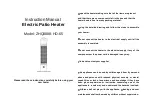
22
gas piping
Contact your local gas service company to ensure that adequate
gas service is available and to review applicable installation codes
for your area.
Size the main gas line in accordance with Table 7. The figures shown
are for straight lengths of pipe at 0.5 in. W.C. pressure drop, which is
considered normal for low pressure systems. Note: Fittings such as
elbows, tees and line regulators will add to the pipe pressure drop.
Also refer to the latest version of the National Fuel Gas Code.
Schedule 40 Steel or Wrought Iron Pipe is the preferred material
for the gas line of this water heater. It is imperative to follow the
sizing recommendations in the latest version of the National Fuel
Gas Code if Corrugated Stainless Steel Tubing (CSST) is used as
the gas line for this water heater.
The heater is not intended for operation at higher than 14.0" W.C.-
natural gas, (1/2 pound per square inch gage) supply gas pressure.
exposure to higher supply pressure may cause damage to the
gas valve which could result in fire or explosion. If overpressure
has occurred such as through improper testing of gas lines or
emergency malfunction of the supply system, the gas valve must be
checked for safe operation. make sure that the outside vents on the
supply regulators and the safety vent valves are protected against
blockage. These are parts of the gas supply system, not the heater.
Vent blockage may occur during ice storms.
table 7. maXimum capacity of pipe in
cubic feet of gas per hour
(Based upon a Pressure Drop of 0.5 inch Water Column and
0.6 Specific Gravity Gas and max. gas pressure of .5 psig)
length
in feet
nominal iron pipe siZe (inches)
1/2
3/4
1
1 1/4 1 1/2
2
2 1/2
3
4
10
175
360
680
1,400 2,100 3,950 6,300 11,000 23,000
20
120
250
465
950
1,460 2,750 4,350 7,700 15,800
30
97
200
375
770 1,180 2,200 3,520 6.250 12.800
40
82
170
320
660
990
1,900 3,000 5,300 10,900
50
73
151
285
580
900
1,680 2,650 4,750
9,700
60
66
138
260
530
810
1,520 2,400 4,300
8,800
70
61
125
240
490
750 1,400 2,250 3,900
8,100
80
57
118
220
460
690
1,300 2,050 3,700
7,500
90
53
110
205
430
650
1,220 1,950 3,450
7,200
100
50
103
195
400
620
1,150 1,850 3,250
6,700
125
44
93
175
360
550
1,020 1,650 2,950
6,000
150
40
84
160
325
500
950
1,500 2,650
5,500
175
37
77
145
300
460
850
1,370 2,450
5,000
200
35
72
135
280
430
800
1,280 2,280
4,600
It is important to guard against gas valve fouling from contaminants in
gas ways. Such fouling may cause improper operation, fire or explosion.
If copper supply lines are used they must be internally tinned and
certified for gas service. Before attaching the gas line, be sure that
all gas pipe is clean on the inside.
To trap any dirt or foreign material in the gas supply line, a sediment
trap must be incorporated in the piping (see Figure 20). The sediment
trap must be readily accessible and not subject to freezing conditions.
Install in accordance with recommendations of serving gas suppliers.
refer to the latest version of the National Fuel Gas Code.
To prevent damage, care must be taken not to apply too much torque
when attaching gas supply pipe to gas valve inlet.
Apply joint compounds (pipe dope) sparingly and only to the male
threads of pipe joints. Do not apply compounds to the first two threads.
use compounds resistant to the action of liquefied petroleum gases.
gas meter siZe – natural gases only
Be sure the gas meter has sufficient capacity to supply the full rated
gas input of the water heater as well as the requirements of all other
gas fired equipment supplied by the meter. If gas meter is too small, ask
the gas company to install a larger meter having adequate capacity.
gas piping and sediment trap installation
figure 20.
gas line leak testing
Fire and Explosion Hazard
Leak test before placing the water
heater in operation.
Disconnect gas piping and main gas
shutoff valve before leak testing.
Install sediment trap in accordance
with NFPA 54.
Use joint compound or Teflon tape
compatible with propane gas.
Any time work is done on the gas supply system perform a leak test
to avoid the possibility of fire or explosion.
1. For test pressures exceeding 1/2 psi (3.45 kPa) disconnect the
water heater and its main Gas Shutoff Valve from the gas supply
piping system during testing, see Figure 20. The gas supply line
must be capped when disconnected from the water heater.
2. For test pressures of 1/2 psi (3.45 kpa) or less, the water heater
need not be disconnected, but must be isolated from the supply
gas line by closing the main Gas Shutoff Valve during testing.
3. Coat all supply gas line joints and connections upstream of the
water heater with a non-corrosive soap and water solution to
test for leaks. Bubbles indicate a gas leak. Do not use matches,
candles, flame or other sources of ignition for this purpose.
4. repair any leaks before placing the water heater in operation.
purging
Gas line purging is required with new piping or systems in which air
has entered.
Purging should be performed per the current edition of NFPA 54 the
National Fuel Gas Code.
Summary of Contents for GPG 81-140
Page 25: ...25 LIGHTING OPERATION LABEL Figure 21 Label for Natural AND LP Gas Models ...
Page 53: ...notes 53 ...
Page 54: ...notes 54 ...
















































